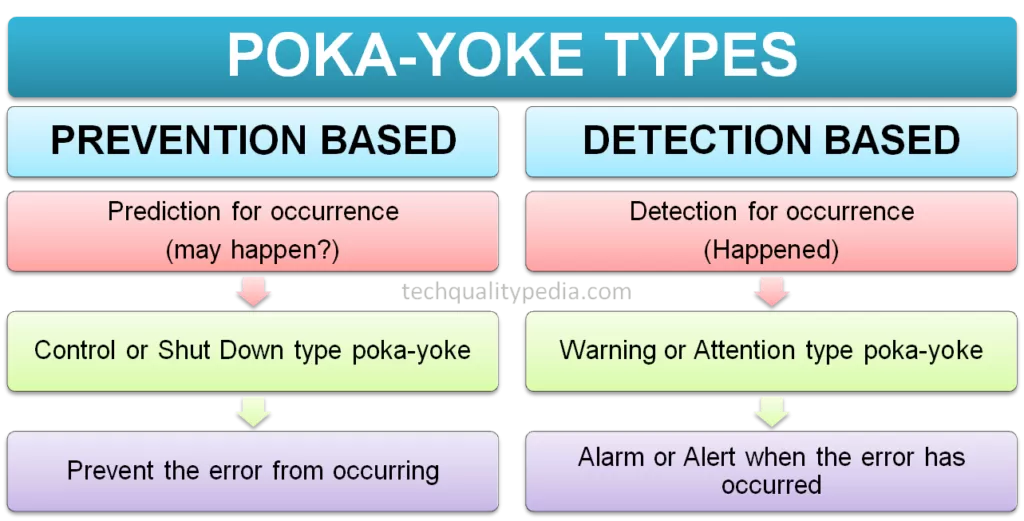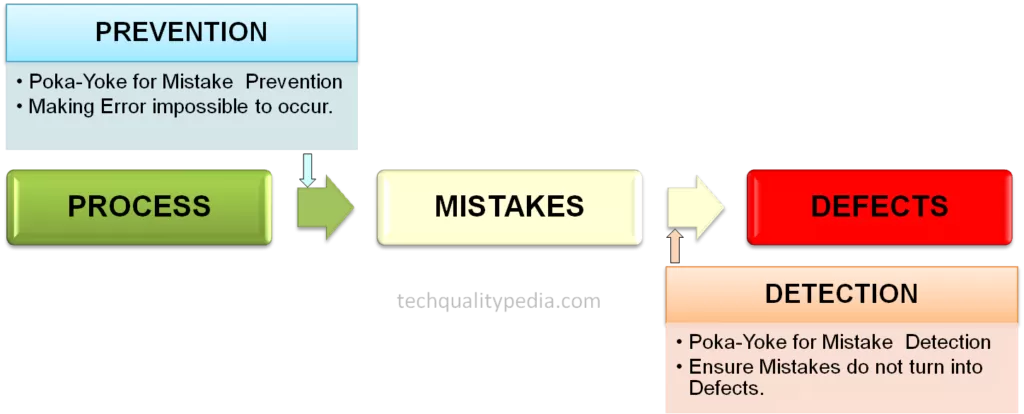Shigeo Shingo of Japan invented the concept called Poka Yoke in the 1960s for preventing human errors.
Poka poke is a Japanese term that means Mistake Proofing or Error Proofing.
Shigeo differentiated the concepts of human mistakes and defects in the manufacturing process. According to him, “defects occur only when mistakes are permitted to reach the customer”.
The essential idea of Poka Yoke is to design your process so that chances of mistakes are eliminated at source or at least easily detected and corrected.
Mistake Proofing is one of the important tools of Lean Manufacturing and Six Sigma methodology.
Table of Contents
Poka Yoke Means | Objective
Poka-yoke means-making the system/process mistake proof or error-proof so that defects generation can be eliminated at source or at first place, and can be easily detected and corrected.
It is an improvement tool for the detection and prevention of mistakes/defects/errors at the manufacturing process stage with the objective of achieving zero defects.
Poka Yoke types
Poka yoke categorized into main two types:
- Prevention type
- Detection type

Prevention type: In this type of poka-yoke system, a process is designed so that the defect or mistakes is impossible to occur.
In simple words, prevention poka-yoke not allowing the possibility for the mistake to occur in the first place.
We can prevent the occurrence of human error by:
- Elimination
- Prevention
- Replacement
- Facilitation
Detection type: In this type of poka-yoke system, mistakes or errors are easily detected and corrected at the source or next work station. We make sure that mistakes do not turn into defects and reach to customer end.
In simple words, detection poka-yoke allowing the mistake to occur but provide some means of detecting, alerting, and correcting it.
We can minimize the effects after occurrence of human by:
- Detection
- Correcting or Mitigating.
In manufacturing industries, prevention poka-yoke generally considered better than the detection poka-yoke.

Mistake Proofing Procedure | Implementation steps
- Review the complete manufacturing process flow and identify where the human mistakes or errors are likely to occur. PFC and PFMEA are the most effective tools that can be used for reviewing and analyzing the process effectively.
- Identify the source of occurrence for each defect or error.
- Re-design the process to eliminate the chances of error.
- If error prevention is not possible, then introduce a detection type poka-yoke system so that error can be easily detected and corrected immediately.
- Select the best method or device for each error.
- Implement the best mistake-proofing system.
- Monitor the proper functioning of the poka-yoke system at regular intervals.
How does Mistake Proofing help?
Defects in the manufactured products adversely affect our employees (injuries), and customers & end-users(dissatisfaction due to defects). Defects result in waste that increases the cost of production.
In manufacturing industries, it is very difficult and expensive to find all defects through a 100 percent inspection process. And correcting defects (by using non-value added activities like rework and repairing) at each stage of production is also more expensive.
Poka-Yoke is an effective tool that helps to prevent, detect, and correct the mistakes or defects from a manufacturing process and therefore improving the quality and reducing cost.
Poka Yoke Approaches | Regulatory Functions
There are two types of regulatory function to prevent and detect errors, or we can say there are two types of approaches for mistake-proofing devices:
- Control Approach
- Warning Approach
Control Approach: Control approach senses the error/problem and stops or shut down the machine/process so that corrective measures can be taken quickly, and thus preventing defects occurrence.
Warning Approach: The warning approach signals the occurrence of defects or mistakes through buzzers, lights, or other warning devices. However, the warning method does not shut down the machine or process on every occurrence.
Poka Yoke System | Method | Devices
Poka Yoke devices consist of three methods for prevention and detection of errors/mistakes in manufacturing process.
- Contact method
- Fixed-Value method
- Motion-step method
Each method listed above can be applied in Control approach or Warning approach.
Contact method: Contact methods involve testing/inspecting for product parameters and other physical attributes such as size, shape, color, etc. to identify if any error exists.
Examples of contact devices are- Limit switches, toggle switches, and physical contact sensors.
Motion or sequence method: The motion method determine that whether the defined sequence of operation has been followed.
Counting or Fixed-value method: The counting method alerts the machine operator if the number of items, movements, or events is not followed or made.
For example, five screws required to assemble a case. A counter device on the tool/machine keeps track of the no. of screws used.
Sources of errors
Sources of errors in manufacturing or service industries classified in terms of 6Ms factors:
- Man or Human error
- Machine
- Method
- Material
- Measurement
- Mother nature or Environment.
Any one of above or combination of two or more factors may cause error in process that can lead to defects.
Poka Yoke Examples in Manufacturing
- The machine does not operate until the door is closed.
- Fixture design to holds the part with correct orientation only.
- Fixture design does not allow the part to rest on the fixture if specifications or parameters of the part fall out of tolerance.
- Safety and power guards on moving parts of the machine to prevent accidents.
- Operation missing parts detection using sensors or physical means. e.g. Drilling miss operation part gets detected at the next station through locator pin provision on the fixture.
- Press machines that operate using both hands ensure that some distance is kept between the operator and machine.
Some other mistake proofing examples in manufacturing industries are:
- Buzzers/alarms
- Guide pins/Locator pins
- Counting devices
- Limit switches
- Area sensors
- Presence check
- Two hand operations.
- Colour codes
Poka Yoke Benefits
Benefits of Poka-Yoke implementation are:
- Elimination of mistakes/errors/defects before they occur.
- Detecting and correcting defects as they occur.
- Improvement in product and process quality
- Reduction in cost due to poor quality.
- Reduction in customer complaints and rejection.
- Prevention of defect outflow to customer.
- Elimination of unwanted operations related to quality control.
- Higher productivity.
- Less bourdon on workers.
- Enhance customer satisfaction.
See also




